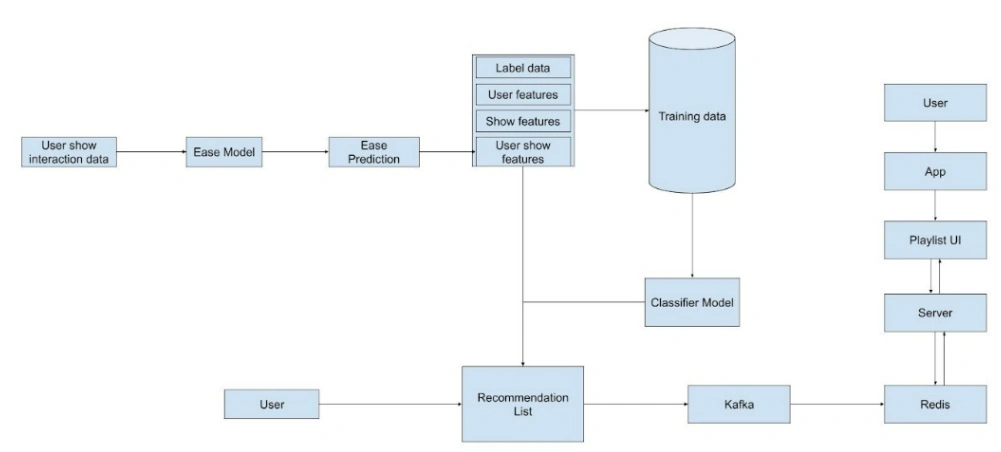
Imagine a personalized audio stream that never stops. That's the power of Pocket FM's Autoplay feature. Designed to enhance your listening experience, Autoplay ensures seamless transitions between shows, creating a dynamic, tailored playlist for you. This blog explores the intelligent recommendation model that powers this magic, revealing how it keeps users engaged, reduces decision fatigue, and sets the stage for a truly effortless audio journey. We'll also glimpse into the exciting future of Autoplay.
At Pocket FM, we believe great storytelling should feel effortless. That’s why Autoplay isn’t just a feature, it’s a central part of how we craft users' listening experience. As soon as users start engaging with an audio series, Autoplay gets to work in the background, building a personalized playlist that keeps users going without interruption.
Using signals from users' in-app behavior, such as what they listen to, skip, or complete, we tailor the next show specifically to users' interests. The result is a curated, dynamic stream of content that feels made just for users.
Autoplay shines in moments when convenience matters most: during a commute, while multitasking, or even with the screen locked. There’s no need to navigate through menus or choose what to play next. It all just flows, so users can stay immersed in the story, hands-free and hassle-free. This is the experience Autoplay is designed to deliver: smooth, smart, and deeply personal.

Left (User Interface of the player when they are listening to an audio series), Right(User Interface for playlist just below the player)
Behind the scenes at Pocket FM, creating a seamless and personalized listening experience involves a carefully orchestrated system. Every time a user starts an audio series, an API request is triggered to fetch their custom playlist from our Redis cache. But this isn’t a one-time list; it’s a dynamic, evolving queue that updates daily to reflect the listener’s changing tastes and habits.
At the heart of this process is our hybrid recommendation model, which combines user data and intelligent algorithms to generate playlists tailored to individual preferences. It draws from both explicit signals and implicit signals to understand what each user enjoys most. Once the playlist is generated, it’s routed through Apache Kafka and pushed back to Redis, ready to be delivered in real-time. This system ensures that each user receives a fresh, relevant, and uninterrupted stream of content every time they press play.

Architecture of Autoplay feature pipeline
At Pocket FM, creating a personalized listening journey requires more than just surface-level matching; it demands a system that understands user behavior deeply and evolves with it. To achieve this, we’ve built a hybrid recommendation model that combines the strengths of collaborative filtering and a tree-based ensemble Model. This system dynamically generates tailored playlists for each user, ensuring relevance, variety, and engagement.
At the core of our hybrid setup is a customized version of the EASE (Embarrassingly Shallow AutoEncoder) model, a well-known item-item collaborative filtering technique. EASE is especially effective for sparse interaction data and works well in scenarios with implicit feedback, making it a great fit for audio platforms like ours.
To make it even more suitable for our use case, we extended the original model to handle both cold-start and warm-start challenges. One of our key enhancements is the addition of a bias term, which helps improve predictions for users or shows with limited interaction history. This bias is tunable, allowing us to optimize for various business objectives, such as engagement, retention, or monetization.
Instead of relying on EASE’s traditional closed-form training, we use Stochastic Gradient Descent (SGD). This enables the model to learn and adapt over time, making it more responsive to evolving user behavior. The result is a lightweight yet powerful recommender that forms the foundation of our personalization engine.
Complementing EASE is our tree-based ensemble classification model, which adds a layer of supervised learning to the recommendation pipeline. This model evaluates user-show pairs to determine the likelihood of meaningful engagement.
We define a positive label when a user listens to a show and surpasses a specific playtime threshold in a future session. Negative labels include partially played content and a sample of shows the user hasn’t played. These labeled interactions form the training data for the model, which uses a rich set of features from user attributes, show metadata, and historical behavior, along with predictions from the EASE model.
By combining these signals, the ensemble model adds precision and context-awareness to the recommendation system. Together, EASE and the ensemble classifier generate playlists that are not only relevant but also deeply aligned with user preferences.
This hybrid approach has led to significant improvements in the listening experience. Offline testing showed a ~15% uplift in NDCG@10, while online experiments demonstrated a 40% increase in playlist playtime, even though some of it was cannibalized from other sources. These gains underscore the impact of combining collaborative and supervised methods in playlist relevancy.
The autoplay feature improves the user experience by providing a continuous and personalized listening journey. Users benefit from seamless transitions between audio series, reducing decision fatigue and optimizing their time spent on the platform. This hands-free operation not only enhances engagement but also encourages users to discover and consume more content, fostering a deeper connection with the platform.
With autoplay, users enjoy a curated playlist, promoting effortless content discovery and optimized listening flow. Beyond the convenience of hands-free operation, autoplay serves as a tool for promoting new and diverse content, ensuring that users are not only engaged but also exposed to a variety of offerings, enriching their overall experience on the platform.
Looking forward, the future of Pocket FM's Autoplay feature is poised for comprehensive enhancements. We’re actively exploring sophisticated model architectures, including neural networks, learning-to-rank techniques, and sequence modeling, while refining our labeling strategies and incorporating new signals to boost efficiency and accuracy even further. Regional optimization efforts will be intensified, tailoring the feature to address specific challenges and cultural nuances in key markets like India. Ultimately, our strategic future aims to make Autoplay even more adaptive, user-centric, and finely attuned to the diverse preferences of Pocket FM's audience, ensuring your story, and ours, continues uninterrupted.